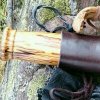Hi,
After following these forums for a while, I'm starting to feel inspired to make a knife! I'm just at the researching stage now and was wondering about the process of prepping wood (preferably found in local woodland etc.) For the scales..
Can anyone recommend any good resources that I should take a look at?
Thanks
Scott
Sent from my GT-I9195 using Tapatalk
After following these forums for a while, I'm starting to feel inspired to make a knife! I'm just at the researching stage now and was wondering about the process of prepping wood (preferably found in local woodland etc.) For the scales..
Can anyone recommend any good resources that I should take a look at?
Thanks
Scott
Sent from my GT-I9195 using Tapatalk

